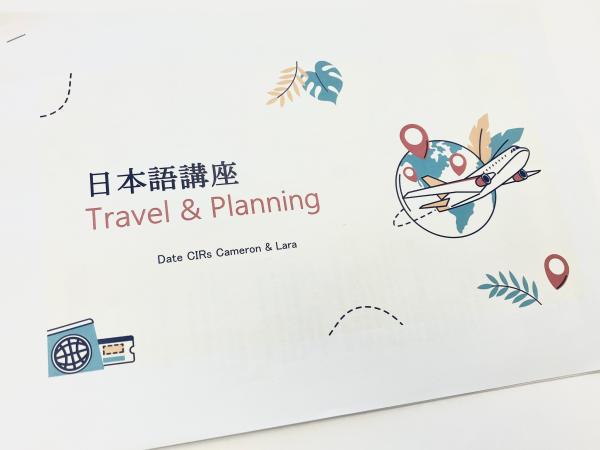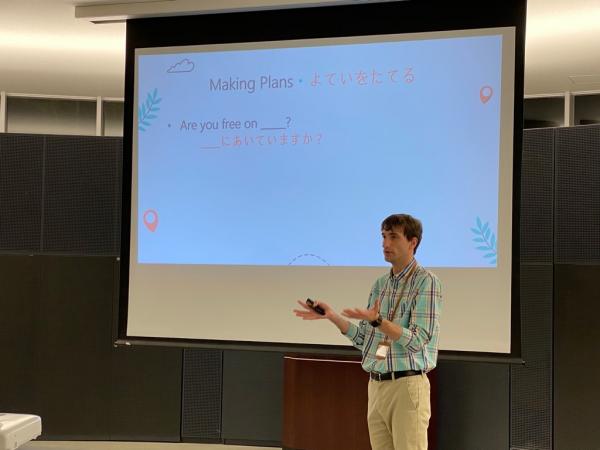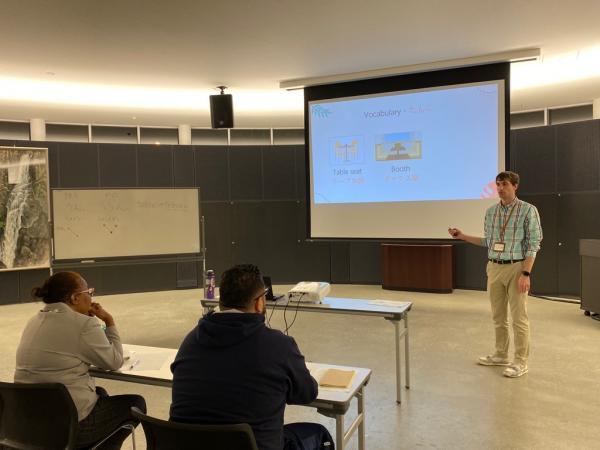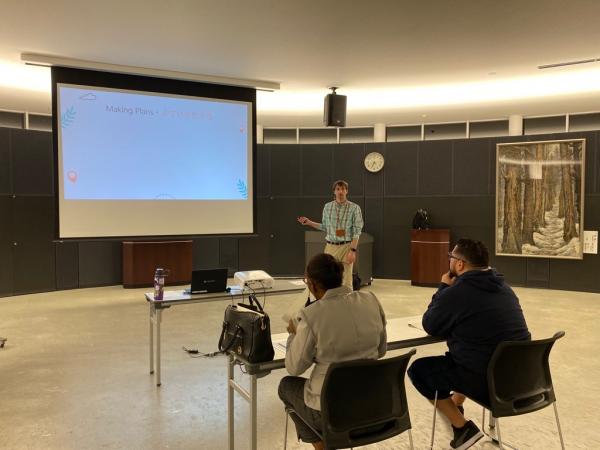本文
Japanese Lesson・日本語講座
In my first post, I (Cameron) had shared my first time participating in our CIR-led English class, so this time I would like to share my experience teaching our Japanese class for foreign residents of Date City.
最初の投稿で、僕(キャメロン)は国際交流員による英語講座を初めて開催した時のことを話しました。今回は、市内に住んでいる外国人向けの日本語講座を開催した経験を紹介したいと思います。
We hold a Japanese class at city hall six times a year, in a similar format to our English classes. As usual, I had Lara accompany me for the class which was a big help when answering questions from the students or explaining points further. One such question this time was the difference between 行ってみたい (ittemitai) and 行きたい (ikitai), which are both words that express the desire to go somewhere. With the help of Lara, we were able to give a proper answer.
英語講座と同じように、日本語講座も市役所で年に6回行っています。今回もララに同行してもらい、参加者からの質問に答えたり、ポイントをさらに説明したりするときにサポートしてもらいました。今回の質問のひとつは、「行ってみたい」と「行きたい」の違いでした。ララの助けを借りて、適切に答えることができました。
This time the theme for the Japanese class was about travel and making plans. I used this theme for a recent English class as well, and felt that foreign residents would also enjoy and find the words and phrases taught in the lesson to be useful in their daily life and travels around Japan.
今回の日本語講座のテーマは、旅行と計画を立てることでした。前回の英語講座でもこのテーマを使いましたが、外国人の方にも楽しんでいただけると思いました。日常生活や日本国内で旅行する際に役立つ単語やフレーズを学ぶことができる内容でした。

The first section covered airport-related vocabulary, such as “luggage”, “seat”, or “reservation.” The next section was focused on using the new vocabulary words by asking the students a set of questions in Japanese regarding a flight itinerary. For example, “What time will they depart?” or “What is their destination?” were some of the questions I had prepared.
最初のセクションでは、「荷物」、「席」、「予約」といった空港関連の単語を紹介しました。次のセクションでは、フライトの旅程について日本語で質問し、新しい単語を使うことに焦点を当てました。例えば、「何時に出発しますか」、「目的地はどこですか」などの質問がありました。
As many people make plans with others when they travel, I also included a brief section with some key phrases to use, as well as a sample dialogue that we analyzed together. Some of the phrases included were “Are you available on Saturday?” and “What time is best for you?”
また、旅行するときに友達などと予定を立てる人が多いと思いますので、役立つフレーズや、サンプル会話も紹介して、一つ一つの文章を一緒に翻訳しました。その中には、「土曜日は空いていますか」や「何時がいいですか」といったフレーズも含まれていました。

Of course when you travel, you’ll be eating out often, so I prepared a section to introduce Japanese words and phrases relevant to dining out. I introduced important phrases that restaurant staff will likely use such as “How many people are in your party?” or “Are you ready to order?”
旅行といえば、外食が多いので、日本の店にまつわる日本語も紹介しました。例えば、「何名様ですか」や、「ご注文はお決まりですか」などです。

This was followed by two smaller sections that contained vocabulary and phrases regarding hoteIs and taxis in Japan.
続いて、日本のホテルやタクシーに関する単語やフレーズを学べるセクションもありました。
Lastly, we focused on two beginner Japanese grammar points. The first one discussed was Vたり、Vたりします(V+tari, V+tari shimasu), which is used to list actions and states. For example, 雨が降ったりやんだりしています (ame ga futtari yandari shiteimasu), meaning “The rain has been stopping and starting.”
最後に、初級の日本語文法を2つ取り上げました。最初に取り上げたのは、「○○たり、○○たりします」。例えば、「雨が降ったりやんだりしています。
To conclude the grammar section and lesson over all, I introduced the grammar point that uses し(shi), which is used when listing multiple verbs, nouns, or adjectives. For example, お金もあるし、時間もある (okane mo aru shi, jikan mo aru), meaning “I’ve got both money and time.”
最後に、複数の動詞や名詞、形容詞を並べるときに使う「し」を使った文法を紹介しました。たとえば、「お金もあるし、時間もある」。

As usual, the class was a lot of fun and I look forward to our upcoming English and Japanese classes in the coming months!
今回の講座もとても楽しかったです。これからの日本語や英語講座に是非、参加を!
(Posted by: Cameron ・ 作成者:キャメロン)









